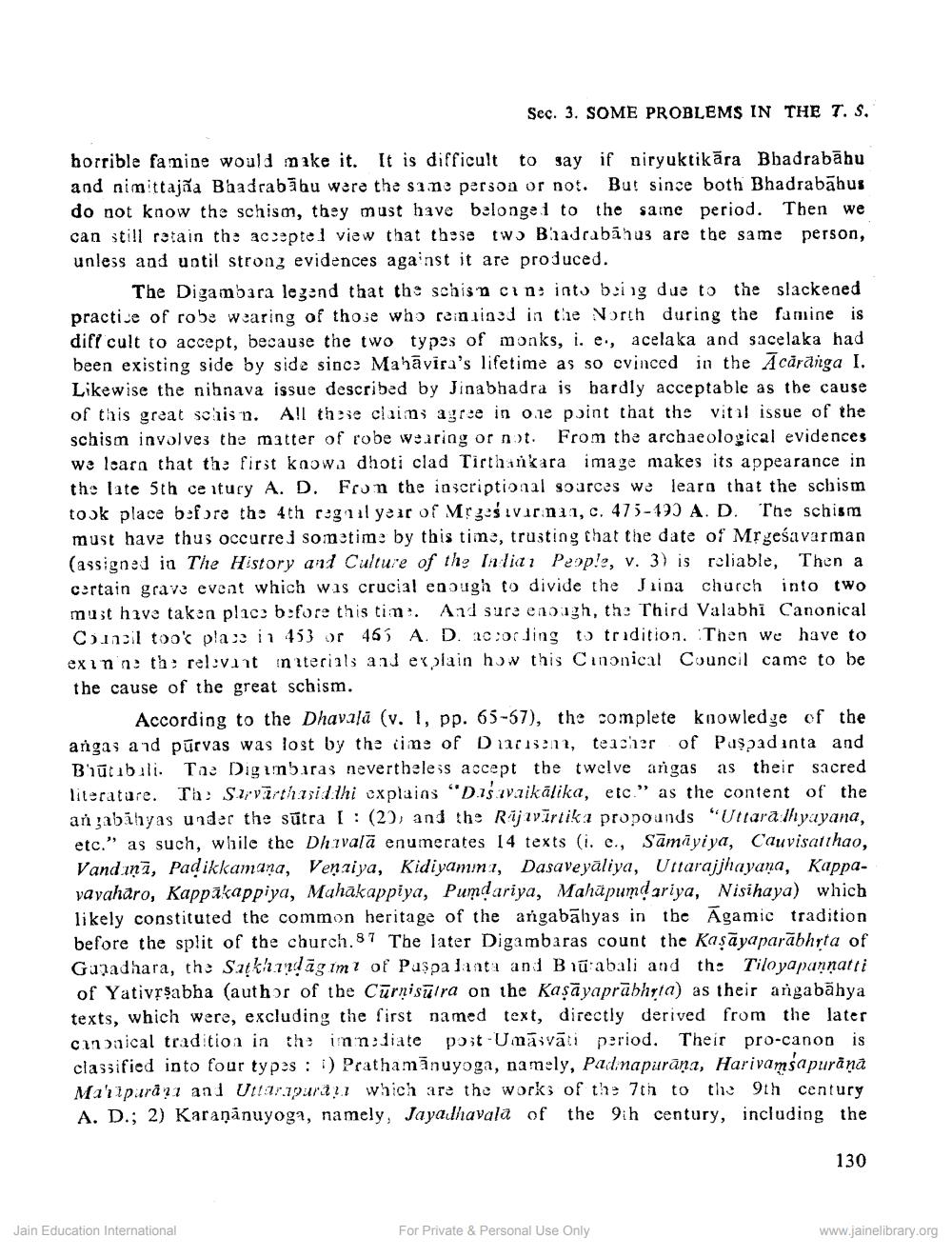________________
Sec. 3. SOME PROBLEMS IN THE T. S.
horrible fanine would make it. It is difficult to say if niryuktikāra Bhadrabāhu and nimittajña Bhadrabāhu were the same person or not. But since both Bhadrabābus do not know the schism, they must have belonged to the same period. Then we can still retain the accepted view that these two Bhadrabāhus are the same person, unless and until strong evidences against it are produced.
The Digambara legend that the schisn cin: ints being due to the slackened practice of robe wearing of those who remained in the North during the famine is diff cult to accept, because the two types of monks, i. e., acelaka and sacelaka had been existing side by side since Mahāvira's lifetime as so cvinced in the Ācāranga I. Likewise the nihnava issue described by Jinabhadra is hardly acceptable as the cause of this great schis n. All these clains agree in one point that the vital issue of the schism involves the matter of robe wearing or not. From the archaeological evidences we learn that the first knowa dhoti clad Tirthnkara image makes its appearance in the late 5th century A. D. From the inscriptional soarces we learn that the schism took place before the 4th cegul year of Mrześlvirnui, c. 475-197 A. D. The schism must have thus occurred sometime by this time, trusting that the date of Mrgesavarman (assigned in The History and Culture of the India. Peop!?, v. 3) is reliable, Then a certain grave event which was crucial enough to divide the Jina church into two must have taken place before this tim. And sure enough, th: Third Valabhi Canonical Comel too's plase in 453 or 451 A. D. 20:ording to tradition. Then we have to ex inn th: relevant interials and explain how this Canonical Council came to be the cause of the great schism.
According to the Dhavală (v. 1, pp. 65-57), the complete knowledge of the angas and purvas was lost by the iine of D11132n2, teacher of Paspadinta and Brūtabuli. Tas Dig inbiras nevertheless accept the twelve argas as their sacred literature. Th: Slvārthasid thi explaias "Dis zvazikālika, etc." as the content of the an zabāhyas under the sūtra 1 : (2), and the Rijavīrtik a propounds "Uttara lhyayana, etc.” as such, while the Dhzvalā enumerates 14 texts (i. c., Sāmāyiya, Cauvisatthao, Vand ınī, Padikkamaņa, Venziya, Kidiyamını, Dasaveyāliya, Uttarajjhayana, Kappayayaharo, Kappakappiya, Mahakappiya, Pumdariya, Mahäpumdariya, Nisihaya) which likely constituted the common heritage of the angabāhyas in the Agamic tradition before the split of the church.87 The later Digambaras count the Kasāyaparābhrta of Guradhara, the Satkhidāgimt of Paşpalanta and Bū'abali and th: Tiloyapannatti of Yativrsabha (author of the Cūrnisülra on the Kasāyaprābhyta) as their angabāhya texts, which were, excluding the first named text, directly derived from the later camaical tradition in the innslate post-Umāsvāti period. Their pro-canon is classified into four types : i) Prathamānuyoga, namely, Padinapurāņa, Harivansapurāņā Maripararı ani Uttarariri which are the works of the 7th to the 9th century A. D.; 2) Karaņānuyoga, namely, Jayadhavala of the 9ih century, including the
130
Jain Education International
For Private & Personal Use Only
www.jainelibrary.org




